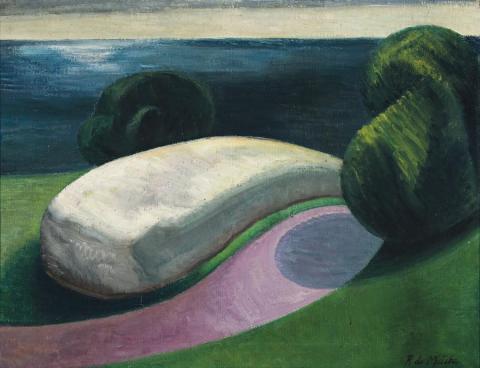THE GREAT STONE, 1932
Roy de Maistre
oil on canvas
71.0 x 92.5 cm
signed lower right: R de Maistre
Dimitrije Mitrinovic, United Kingdom
Trustees of the New Atlantis Foundation, United Kingdom
Gladys MacDermot, London
Thence by descent
Private collection, Switzerland
Sotheby's, Melbourne, 24 November 2008, lot 73
Company collection, Victoria
Roy de Maistre: A Retrospective Exhibition of Paintings and Drawings 1917–1960, Whitechapel Art Gallery, London, May – June 1960, cat. 20
New Statesman , 11 June 1960
Johnson, H., Roy de Maistre: The English Years 1930-1968, Craftsman House, Sydney, 1995, pp. 57, 58, pl. 27 (illus.)
When Roy de Maistre and Roland Wakelin were exploring colour theory and the relationship between art and music, their starting point was the landscape, conceived in high-keyed, vibrant colours and geometric form. Wakelin's painting Synchromy in Orange Major, 1919, is a classic example. De Maistre went even further in Rhythmic Composition in Yellow Green Minor, 1919, among the first purely abstract works painted in Australia. Both are in the collection of the Art Gallery of New South Wales. About this time de Maistre also painted Flowerbed, Botanical Gardens, Sydney (private collection), the affinity between his abstract work and the landscape being quite striking in the flow of forms, sensuous curves and seductive colours. Landscape provided the framework for inventive exploration, as colours coax the eye to walk the mauve garden path and seek what lies behind the blue-shadowed tree and gentle hues of the distant, placid waters. While the painting is its own entity, narrative is generated through symbolism to journey beyond the material. The object is the mere reflection of the inner spiritual force or being.
In London some years later, de Maistre returned to this painting as the inspiration for The Great Stone, 1932. Heather Johnson, in her monograph on de Maistre's English years, noted, 'Rather than being a variation of the first work, as was the case with most of de Maistre's reworking of paintings, The Great Stone is totally removed in subject and feeling from the original painting.'1 The flowerbed, she said, had 'become a surging, spiritual, abstract power.' The force of its imagery was not lost on others. The reviewer for the New Statesman wrote of de Maistre's 1960 London retrospective exhibition at the Whitechapel Gallery, '...for me the most compelling images here are two early works, The Great Stone, 1932, and The White Towers, 1934, romantic visions of simple massive static forms pregnant with mysterious force.'2 Like the European Symbolist paintings of the end of the nineteenth century, a work of this kind can lead several ways in imagery and intent. First, there are the various interplays - between flatness and the tactile, sculptural feeling, which are allied to the intentional ambiguity between realism and abstraction as parallels to the symbolism. Then there is the intriguing metamorphosis of the flowerbed, its symbolism being so oblique that it is hard to define. As the dominant form, perhaps that is the point - sculpturally static, curvaceously flowing in the best paradoxical manner of symbols. The Great Stone is a more intellectually intuitive painting. The harmony between and fundamentalism of the forms invite meditation on the same - of reasoned intuition leading to deeper levels of contemplation and perception of the verities.
1. Johnson, H., Roy De Maistre: The English Years 1930-1968, Craftsman House, Sydney, 1995, p. 57
2. Quoted in Johnson, op.cit, p. 57
DAVID THOMAS
